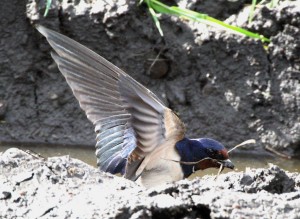 Where and how can I see a first bird migrant is a query often put to me by readers at this time of the year. Unfortunately, there is no quick answer to this query as there are a number of considerations. At the one extreme someone might want to see their first osprey back from the birds’ wintering grounds in Africa. In contrast someone might want to see one of the warbler family, such as the willow warbler, as these are, to many, the essence of migratory birds. The willow warblers will have left the Highlands last August and will have stopped to refuel in Iberia and then taken the longer flights to West Africa. Of course, part of the attraction of migration with birds is the sheer physical effort to fly such long distances. The ospreys have the advantage of their size whilst by comparison the tiny willow warbler seems far too small and fragile to make such epic journeys.
Where and how can I see a first bird migrant is a query often put to me by readers at this time of the year. Unfortunately, there is no quick answer to this query as there are a number of considerations. At the one extreme someone might want to see their first osprey back from the birds’ wintering grounds in Africa. In contrast someone might want to see one of the warbler family, such as the willow warbler, as these are, to many, the essence of migratory birds. The willow warblers will have left the Highlands last August and will have stopped to refuel in Iberia and then taken the longer flights to West Africa. Of course, part of the attraction of migration with birds is the sheer physical effort to fly such long distances. The ospreys have the advantage of their size whilst by comparison the tiny willow warbler seems far too small and fragile to make such epic journeys.
There are many other migrants and some of them go un-noticed or overlooked such as the common sandpiper that breeds alongside rivers and burns. Some birds, such as the tiny wheatear, are more complex in that the first ones we see are almost certainly heading even further north to Greenland. The wheatears that stay here are generally later in arriving and will have spent their winter in Africa. Then there are the family of terns and one, the arctic tern, has an incredible migratory journey. Whilst some nest in the Highlands others nest in the Arctic and they migrate south and winter in the Antarctic – at the other end of the world! Yet seeing them along the coast they seem such small birds and hardly suitable for such epic journeys.
Whilst the cuckoo may be many peoples favourite migrant, there is a group of birds many see, above all other, typifies that the migratory birds. Perhaps it is because one of the them nests so close to ourselves and has been the subject of writers and poets more than any others , the swallow. The swallow is a member of the family that includes house martins and sand martins. The swallow in the photograph is gathering mud for its nest. Swallows and house martins are now so closely linked to ourselves with their nests on buildings that we tend to forget that they once used to breed on cliff faces until our buildings were taken over. Some house martins still nest on cliffs, such as the ones I watched at Tarbetness last year, quite close to the tall, very impressive lighthouse.
Going back to the queries over the first migrants, there is an invaluable aid to which bird to choose by referring to one of the “Highland Bird Reports” that come out annually. There are many very interesting sections to this fine report that is a credit to all concerned in its production and the bird recorders who send in their records. The section is entitled “First and last dates of common migrants”. From this you can get an idea of which are the first migrants to arrive. Furthermore, by referring to the extensive “Systematic list for year” you can see just where they are found, whether breeding or just present. If you want to see an osprey then Loch Garten, near Aviemore, the famous breeding site is a good one. However, I find the first place to see one is often one of the Trout Fisheries such as the one west of Daviot. As for the swallows and sand martins, try some of the local lochs at this time of the year such as Loch Flemington east of Inverness. Good hunting.
Tags: highland wildlife
